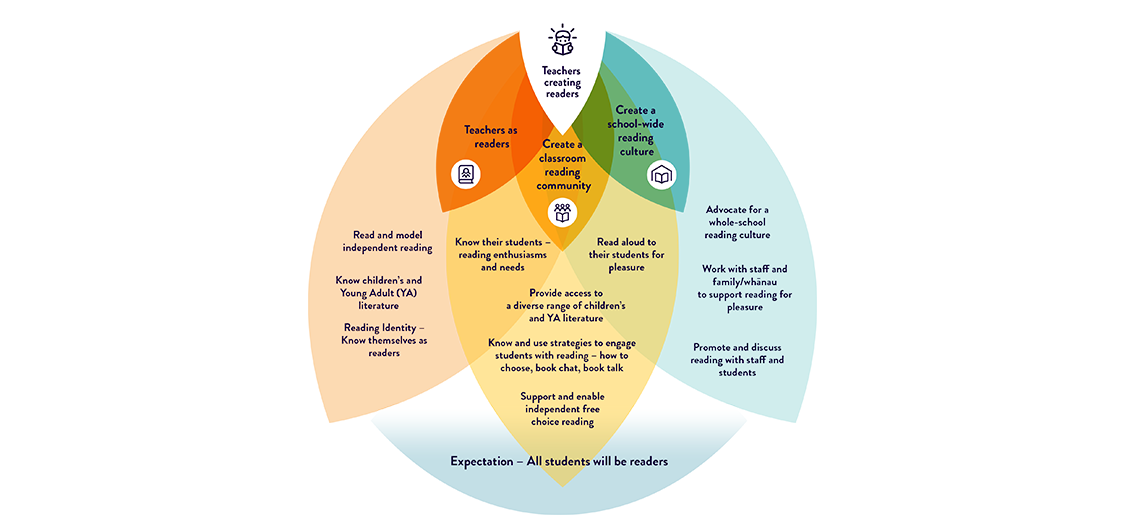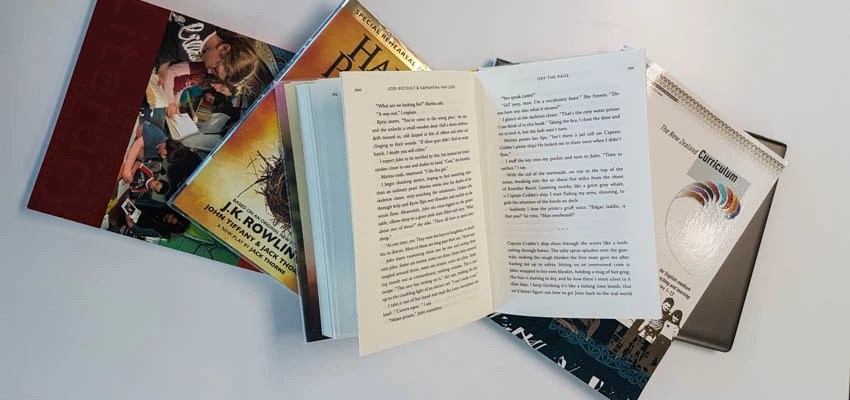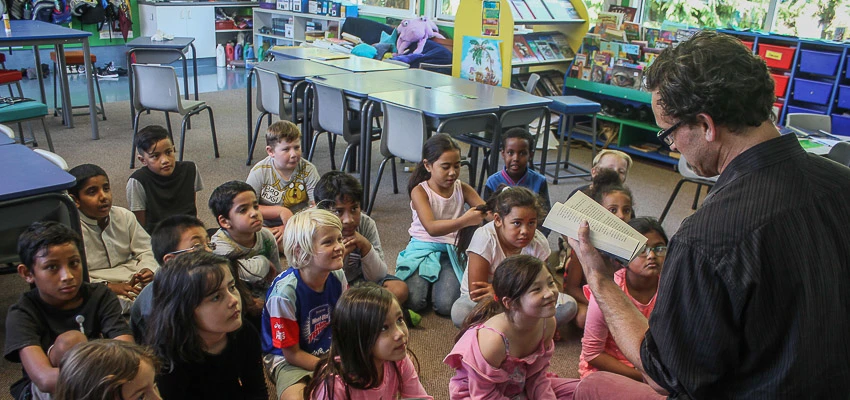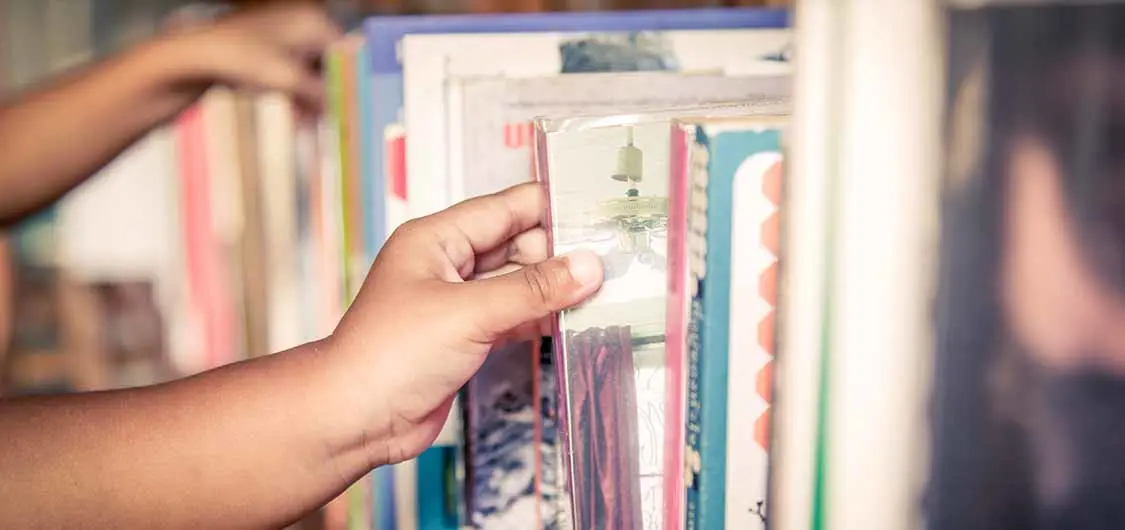Teachers Creating Readers Framework

Explore our Teachers Creating Readers Framework. Download and print posters of the framework.
Teachers creating readers
Reading involves the skill of being able to read and the will or desire to read. So, there is a difference between being able to read and being a reader.
Teachers, like school librarians and whānau, are vital reading role models. Research, including Teresa Cremin’s seminal Teachers as Readers study, highlights ways teachers can inspire, support and encourage students to read for pleasure. These range from reading and knowing children’s and young adult (YA) books to developing a reading-for-pleasure pedagogy.
Reading for pleasure — findings from the Teachers as Readers study (Cremin et al., 2014) on The Open University's Reading for Pleasure website.
The Teachers Creating Readers Framework
The Teachers Creating Readers Framework stems from the knowledge and practice ‘petal’ of the National Library's Reading Community Framework. It draws on research and National Library Services to Schools’ extensive experience working with schools to engage students with reading.
The framework highlights 3 key, interconnected ways that teachers can create readers:
Be a reader themselves (teachers as readers).
Create a classroom reading community.
Create a school-wide reading culture.
Underpinning a school reading culture and best practice is the expectation that all students will be readers.
A school reading community — find out more about creating a school reading community. Download the Reading Community Framework.
Use our posters, explore examples of practice
Use our Teachers Creating Readers Framework posters as a discussion prompt in your school, kura or kahui ako. Explore examples of practice in the poster or on our web page.
Online, accessible version of the poster content
Teachers as readers
Read and model independent reading — understand why reading role models matter. Teachers are readers and are seen to read independently, with pleasure, from choice.
Know children’s and YA literature — know and can recommend children’s and YA literature. Have strategies to find out about and share new books.
Know themselves as readers — reflect on their own experiences of reading and as a reader. Share their reading lives to support students develop their reading identities.
Create a classroom reading community
Know students' reading enthusiasms and needs — discover students' reading preferences and practices in and out of school. This enables personalised recommendations and ways to help students choose books to read for pleasure.
Provide access — ensure students have regular and frequent access to a diverse range of children’s and YA literature. To inspire reading, students need up-to-date and appealing print and/or digital books to read for pleasure at school and home.
Read aloud — from primary through to senior secondary level. Read aloud for pleasure and often. And read from a diverse range of children’s and YA literature from across the curriculum.
Know and use strategies to engage students with reading —
Know how to:
share and chat about books with students
develop strategies and approaches to encourage students to share about books with each other.
Provide students with frequent and regular opportunities to talk about books, stories and reading.
Provide time for independent, free-choice reading — prioritise regular time for independent reading. Examples include sustained silent reading (SSR) and drop everything and read (DEAR). Allow time for students to browse and choose from a range of reading material, settle into the experience and build stamina over time. Role-model reading, and share and chat about their reading in all classes.
Create a school-wide reading culture
Advocate for a whole-school reading culture — know the research about why reading for pleasure is important and how it makes a difference. Advocate across the school community for reading for pleasure. Share the message with school leadership, staff in and across schools, and family/whānau.
Work with staff and family/whānau to support reading for pleasure — share ideas and develop measurable initiatives. Ensure access to reading resources. Strengthen support for students reading for pleasure at school and at home.
Promote and discuss reading with staff and students — promote reading for pleasure in a variety of ways. This ensures it is visible, modelled, celebrated, supported and encouraged. For example, promote through displays, events, author visits, book clubs for students and staff and chats from the classroom to the staffroom.
Related content

School staff as readers
All school staff — leaders, teachers, library staff and others — are vital reading role models. To inspire and encourage your students to become engaged readers, you need to read, know the literature and share your passion.
A school-wide reading culture
A school with a reading culture fosters positive attitudes towards reading. Find out how to create a school-wide reading culture. Use our primary and secondary school review tools to guide you and monitor your progress.
Reading aloud
Reading aloud to children and teenagers is enjoyable and stimulates interest, imagination and a love of reading. Finding and choosing a ‘read-aloud’ that you and your students will enjoy is crucial. Explore our other tips and resources.